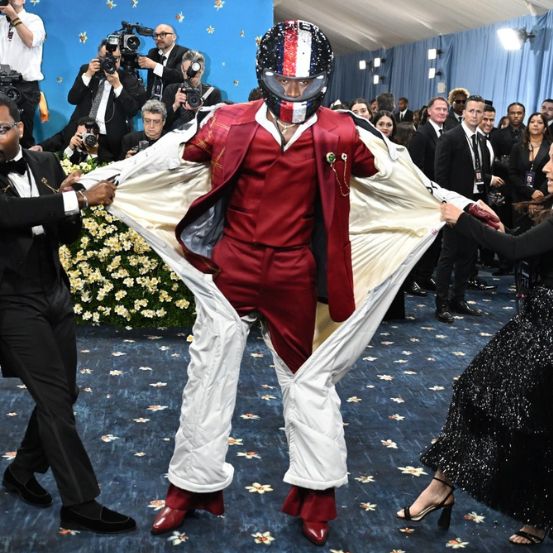Our eyelids were made to display fabulous eyeshadow looks and not the unbearable weight of environmental guilt. Thankfully there are glitter alternatives that are worth celebrating.
Our eyelids were made to display fabulous eyeshadow looks and not the unbearable weight of environmental guilt. Thankfully there are glitter alternatives that are worth celebrating.

© IStock Photos. Artwork by João Oliveira and Mariana Matos
© IStock Photos. Artwork by João Oliveira and Mariana Matos
Some scientific studies estimate that, on average, a human being ingests about five grams of microplastics every week. For the ones that, like me, have some difficulty in understanding exactly what that means, it would be the equivalent of eating a credit card every time you go to the mall on the weekends. Maybe in that way, we can visualize the deep consequences it has on our health. Not just to ours actually, to the planet’s as well. Let us drop the individualistic facade for a few moments and let's look at the big picture. Arianne Amores and Kelly Failliot did it when they decided to create Thesparkleffect, a brand of eco-friendly glitter. “We’ve been a brand of biodegradable glitter from the start because we understood there was a huge gap in the Portuguese market. In Portugal, there is still relatively little information on the importance of using biodegradable glitter, but we’re making all we can to raise awareness on the use of glitter to the consumers,” explain the founders in a brilliant (get it?) exchange of e-mails with Vogue.
“Glitter from Thesparkleffect is made out of vegetable cellulose, that is made out of eucalypt trees, making our product biodegradable, vegan, and ocean-friendly.” The difference between a pot of sustainable glitter and its conventional counterpart, much more polluting, is in its composition. The majority of cosmetic products with glitter that are on the market nowadays are born of a chemical process based on the transformation of materials like plastic or aluminum that are heated to high temperatures in order to get that shiny and reflective look we associate with glitter. In other words, this process is twice as harmful to the environment, since, not only is it a process that requires high energy consumption, but the result of it is a collection of microplastics that will contaminate the planet until its decay. And that along the way manage to be harmful to us as well, explains Kelly Failliot: “The small particles of plastic end up being ingested by plankton, fish, seabird and other sea life forms, entering our own food chain as well.”
When the synthetic materials aren’t in the core of the composition, it’s they’re of mineral origins, like mica, whose extraction is strongly linked to child labor, or titanium dioxide, a material under analysis in the European Union for its link to cancer. Finding the sustainable version of any product can be a true odyssey, but when the product in question is glitter, it would seem we’re in a maze with no way out. Until we see that light at the end of the tunnel. That stroke of hope that makes us believe we can keep playing makeup without hurting the environment or ourselves. Vegan glitter, like the one developed by Thesparkleffect, contributes to that. “This variant of glitter is a huge innovation when it comes to ecologically responsible pigments. (...) Being free of antimony (a possibly toxic component) and plant-based, not plastic, contributes to a sense of safety and for its sustainability,” clarifies Arianne Amores. Another positive characteristic of plant-based glitter is its biodegradability. Just like the way normal glitter insists on staying under your couch, the pigments made out of synthetic materials take centuries to disappear from the face of the Earth - that is if they actually ever do, I - we haven´t been around long enough to answer that question. However, in the words of Arianne and Kelly, it takes just “three to four weeks” for the glitter produced by Thesparkleffect to decompose in its entirety, a period that “depends on environmental and local factors, like heat, humidity and amount of microbes in the air.”
In November of 2021, the University of Cambridge began its search for a vegan composition that would bring glitter the best of both worlds: the guarantee of intense shine and color as well as the assurance of sustainability. The result is promising, even if based on the process already present in nature. More specifically in the wings of butterflies and in the feathers of peacocks. The vibrant colors that are present in both leave us dazzled every time we tune in to National Geographic can now be replicated in our glitter, without fading away with the passage of time. This process is called structural color, and even though its technical specificities are too complex for the space we have left - and, to be honest, to the scientific understanding of the one writing this text - it’s important to point out that this process utilizes nanocrystals of cellulosic origin derived from trees, plants, fruits, and vegetables. These pigments are also biodegradable, free of any toxic components, and, of course, free of plastic. Even though it's still not in the market, we shouldn’t have to wait long until brands can start using the technology in their own glitter manufacturing and, who knows, make the Beauty market a little more sustainable.
It’s equally as important to understand that, with vegan glitter, we don’t come up with a hand full of solutions. There are some challenges as well. For the founders of Thesparkleffect, the answer is simple: the biggest challenge is its price. “For 1 or 2 euros we can buy a bag of 1 kilogram of plastic,” state Arianne and Kelly. “It’s impossible to compete with these prices and that ends up influencing the buyers’ decision.” The businesswomen state they know the vegan glitter buyer has some prior knowledge on environmental conscience and education and, because of it, seeks out options that, even if more expensive, are environmentally friendly. That is why the brand has recently expanded its offers, seeking to enrich its range of products. “The idea of mixing eco-glitter and a Fashion accessory was based on the effort to make a sustainable product of conventional use in an actual fashion statement, that aims at starting a conversation on the urgency of change.” The Sparkle Necklace is one of the brand’s best-sellers and is responsible for a whole new wave of clients that wouldn’t be attracted to the brand if not for this blend of factors. “We’re confident that, with time, more people will be moved to replace their plastic glitter consumption with biodegradable glitter”, conclude Arianne Amores and Kelly Failliot. “Together we can contribute for a brighter future.” And we will. Rihanna has two more years of having everyone sing “shine bright like a diamond”. Soon enough we’ll all be chanting “shine bright like sustainable biodegradable vegan plastic-free glitter.”
Translated from the original on Vogue Portugal's Celebrate Yourself issue, published February 2022.Full story and credits on the print issue.
Relacionados


Para além do espelho: tudo o que precisa de saber sobre procedimentos estéticos
07 May 2025



.png)

.png)
